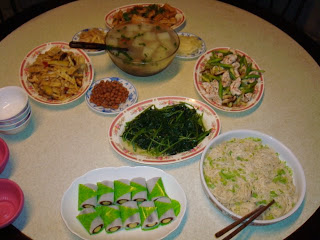The box:


The box has a white sticker at the top which acts as a seal for competition purposes. It says: 2008年春季比賽茶展售會 ("2008 year spring season competition tea event"), 凍頂翠玉茶 ("Frozen Summit Green Jade Tea"), No. 973317 (an item number used for competition purposes), and 南投縣茶商業同業公會 監封 ("Nantou county tea trade guild's strong seal"). Any of you more accomplished Chinese readers are invited to correct or improve my translations.
The can:


The dry leaf:

Beautiful tea soup:


The can has the same text as the box, but on the bottom in big gold characters it also says: 優良獎 ("good prize").
Notice the ring-pull at the top of the can, that feature as well as the vacuum packed bag inside were designed to keep this tea very fresh.
The bag:Notice the ring-pull at the top of the can, that feature as well as the vacuum packed bag inside were designed to keep this tea very fresh.

The bag says: 南投縣茶商業同業公會比賽茶 ("Nantou county tea trade guild's competition tea").
OK... so I have finally gotten to the tea! Here it is. It is very pretty with large plump forest-green rolled leaves and a fresh roasty smell.
The dry leaf:

Dong ding (frozen summit) oolong is a famous product of Nantou county in central Taiwan. Classic dong ding tea, such as this one, has a higher oxidation level and more firing than many newer Taiwanese teas. Because of this, dong ding tea usually keeps its great taste and full body for several years. Some are even intentionally aged and will become better if they're properly stored and baked. I am not worried about this tea changing too much over the next few years so I plan to take my time with it.
On Sunday morning, my wife and I enjoyed 8 great infusions of this competition tea. It delivered a thick smooth body and buttery-caramel aroma. Throughout our relaxed tea session I picked up notes of toasted almonds, honey, ripe apricot and fresh brown rice. Several infusions had time to cool as we played with our 13-month-old daughter. These room temperature cups had a very clean sweet-apple flavor.
Although I'm not sure how this particular tea did in last year's competition, I am personally very pleased with this dong ding and look forward to cupping it again. Perhaps I'll have my next session in about a month to celebrate this tea's first birthday.
On Sunday morning, my wife and I enjoyed 8 great infusions of this competition tea. It delivered a thick smooth body and buttery-caramel aroma. Throughout our relaxed tea session I picked up notes of toasted almonds, honey, ripe apricot and fresh brown rice. Several infusions had time to cool as we played with our 13-month-old daughter. These room temperature cups had a very clean sweet-apple flavor.
Although I'm not sure how this particular tea did in last year's competition, I am personally very pleased with this dong ding and look forward to cupping it again. Perhaps I'll have my next session in about a month to celebrate this tea's first birthday.
Beautiful tea soup:







































